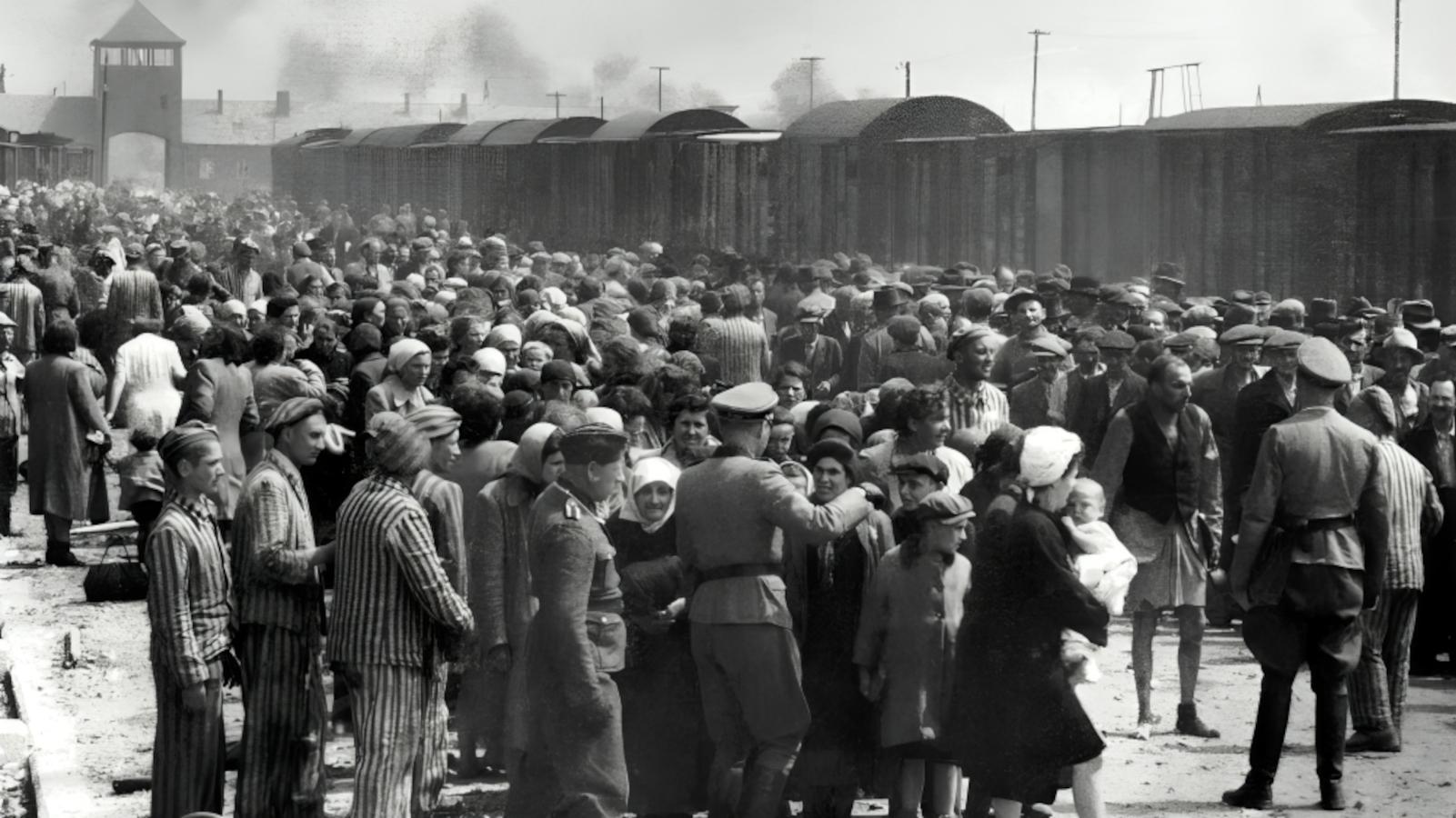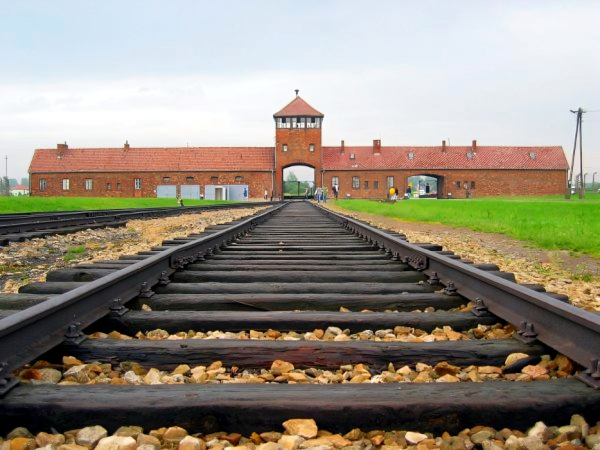Whitewashing Jewish History at Auschwitz
Polish history should not eclipse Jewish history

Recently, I visited Auschwitz.
In 1944, during WWII, my parents had been transported to this Nazi death camp, where my mother’s first sight was of Dr. Josef Mengele, the “Angel of Death. ” Mengele allowed her to survive as she tried saving a young orphaned boy. One of her experiences had been refusing to throw Jewish bodies into a mass grave, defying the orders of a German soldier. She lived to tell her story.
My mother’s family owned one of the largest textile factories in the central Polish region of Lódz. Her family lost their property and their lives to the Nazis. My parents, as a young married couple, had lived in the Lódz ghetto for three years before being transported to Auschwitz during the last year of the war. Both had avoided harder labor at the camps by using their skills as a dressmaker and tailor to sew German uniforms.

C. Puisney via Wikimedia Commons
During my visit to Auschwitz, I was prepared to be grief-stricken by memory of the atrocities suffered by the Jewish people. Instead, I became angry with disbelief at the lack of empathy and respect for the horrors that took place against the Jews in this death-haunted outpost. The museum and tour guides “whitewashed” the experience by replacing much of the Jewish history with a focus on what had happened to the Polish people.
In 1939, 3. 5 million Jews lived in Poland, the largest concentration of any country. That same year, Nazi Germany established the Auschwitz-Birkenau concentration camp, where a total of 1. 1 million Jews would die by the end of the war in 1945. The Nazis deported Jewish people from all their conquered territories—first housing them in disease-ridden ghettos, then using them for slave labor, and finally transferring them by train to concentration camps. With more than 44,000 established camps, ghettos, and other sites of incarceration, the Nazis killed over 6 million Jews, as well as Poles, Romanians, and other prisoners. Not once did our tour guide mention the enormity of these numbers.
The Nazis were clear about their goal—“Jews are a race that must be totally exterminated” said Hans Frank, Governor General of Nazi Occupied Poland, in 1944. Yet, here I was standing at Auschwitz on a tour in 2025, listening to they had the Nazis deported to this slave labor camp “140,000 to 150,000 Poles, 23,000 Romanians, 15,000 Soviet Prisoners-of-War, and 25,000 other prisoners from other ethnic groups. ” The tour guide explained that people were sent to Auschwitz to die. Yet, I was introduced to pristine brick barracks and lawns, the camp having been built to train the Polish military before the Germans invaded. While the camp had originally housed 10,000 prisoners, it was enlarged to hold 30,000 individuals, with up to 400 people living in each barrack.
In spite of the death of 1. 1 million Jews, the “museum” guide, for two hours, told a story of how severely the Poles had suffered at the hands of the Nazis. Unsanitary and crowded conditions brought disease and death. The Nazi soldiers sent sick prisoners to a single hospital barrack, not to be treated, but to die. To set an example for others, soldiers routinely hung Polish prisoners from the gallows or shot them in the courtyard. Camp “physicians” became murderers by experimenting on Polish women to test sterilization techniques, without anesthetics. A small gas chamber was used to kill thousands of people each day using the poisonous pesticide, Zykon B.
On the tour, there were hundreds of pictures on the barracks’ walls honoring Polish criminals and dissidents. The photos included intellectuals and professionals brought to the camp, as the Nazis saw these groups as being antagonistic toward the Third Reich. The Nazis imprisoned university professors and professionals, such as lawyers and doctors. 60% of Poland’s lawyers and 40% of their doctors were Jewish, yet, only a few photos were of Jews, the vast majority being Polish. We were told that the Nazis believed Polish citizens should not be educated, but used for working labor.
Why, I wondered, were we not hearing more about the history of the million Jews who had died here?Where had they been housed? Surely not in these pristine brick barracks, although we viewed displays of their stolen personal belongings—shoes, pots and pans, prayer shawls, and eyeglasses. Nazi soldiers cut women’s hair and sold it to make fabric and clothing. They shipped these goods to the Third Reich for the Germans’ personal use. The guide’s narrative sounded so objective and sterile.
Despite spending several hours at the labor camp, our tour guide met us at Birkenau—the death camp. Here was where the 1. 1 million Jews arrived by railroad cattle cars and were made to strip naked. Some were sent to showers to be disinfected, then assigned to one part of this camp as slave labor, until they died. Most were sent to the showers to be gassed and burned in the crematoriums.
The tour at Birkenau ran a mere 15 to 20 minutes as the guides explained the history of one of the worst atrocities in human history. Unlike Auschwitz’s brick barracks, Birkenau’s shacks were small, wooden, and dilapidated with endless rows of cramped bunks. At any given time, 150,000 people (compared to 30,000 at Auschwitz) were imprisoned at Birkenau as slave labor. Examples of humanity and kindness existed among these prisoners, but such stories were not shared on the tour. At the end of the war, the Germany destroyed and left in ruins the four enormous crematoriums at the far end of the camp, never to be witnessed by the world. The majority of barracks in the camp were torn down by Poles for wood to build homes.
Our guide informed us that she had to remain objective. How can one possibly remain objective in such a place? The Auschwitz “museum” had glossed over Jewish history by focusing on on its Polish story. Most people visiting would not know to visit Birkenau. Thousands of people visit Auschwitz each day, while only a few hundred people visit Birkenau.
My outrage heightened as I left Birkenau, only to see a the book and gift shop, tiny unlike the enormous bookstore, gift shop, and restaurant at Auschwitz. Restroom accommodations at Auschwitz were numerous and free; Birkenau’s were small, cramped, and required visitors to pay for their use. At Birkenau, all dignity for the memories of the dead had been lost.
The mantra for the Jewish people has been “Never Again. ” However, the horrors that occurred at Auschwitz-Birkenau were replicated on a smaller — but no less barbaric — scale when Hamas, the militant arm of the Muslim Brotherhood, broke through the fences separating Gaza from the surrounding Jewish settlements and brutally slaughtered over 1,200 Israeli men, women, and children. Their stated goal, like the Nazis, is the total obliteration of the Jewish people.
Many deny the Holocaust ever occurred. To emphasize the history of the Nazi death camps, thousands of people from all over the world participate in annual remembrance events at Birkenau, such as the March-of-the Living and the JCC Krakow Ride-for-the-Living. These activities neutralize the “whitewashing” of Auschwitz’s Jewish history by honoring those who survived and the memory of the millions who died. These groups build awareness against normalizing global antisemitism that can lead to violence and death. They stand with Israel to prevent another genocide from destroying its people. These events preserve the Auschwitz story by educating future generations and reminding the world— “Never Again. ”